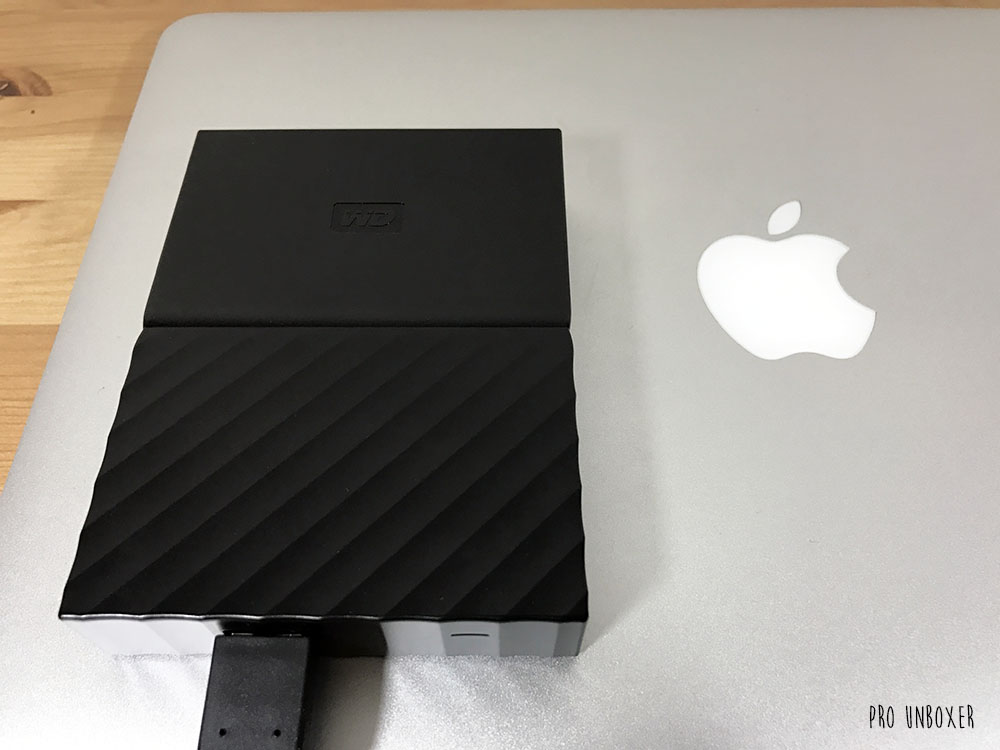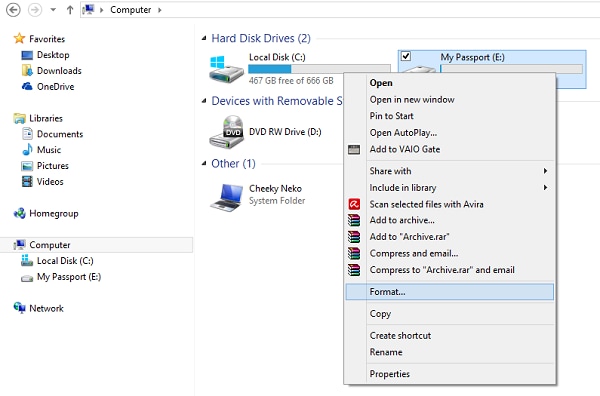- HI all, Ive had a My passport (Windows) for some time, I recently bought a MAC now I need a Passport thats compatitible and it will cost the same to backup and reformat my current one as buying a new one.
- Get deep insights into MongoDB performance. Monitor MongoDB metrics, distributed request traces, and logs, all in one platform. 14-day free trial. Easiest: Format the drive as exFAT (Requires Windows 7 or later, or appropriately updated Windows Vista SP2 or Windows XP with KB955704). Windows Centric.

The Western Digital Passport provides expanded storage space and backup features for Windows-based and Macintosh computers. Format your Passport so the drive is compatible with the backup tools available in Mac OS X and so it can perform the common task of transferring files between the external hard drive and your Mac's internal hard drive. Designed for Mac and ready to be used with Time Machine, the 4TB My Passport for Mac USB 3.0 Type-C External Hard Drive from WD can be used to create system backups, store your photos and videos and much more. The drive comes preformatted in HFS+ for Mac and works out of the box; simply plug the drive in and begin transferring your files. The wd software will not work on windows RT, but the drive will work as normal, if there is no password on the wd drive. Use a computer with out windows RT on it and remove your password. Then plug it into your surface with windows RT. Ya, I ended up going with the WD My Passport for Mac, because the price on Amazon was the same, and I like the silver look. But any of them should work for both Mac and Windows if you format them correctly, assuming your machine has the necessary ports.
Related Articles
- 1 Import Files From an External Hard Drive Easily
- 2 What to Do If a PC Doesn't Recognize a Used Hard Drive
- 3 Scan a Hard Disk for Bad Sectors
- 4 Get to the Root Directory in DOS
To make your Western Digital hard drive work on both Mac and Windows computers, you need to format the drive with the FAT32 file system. Although both operating systems can format your drive with the FAT32 system, Windows 7 limits the partition size to just 32GB, but you can format up to 1TB drives through the Windows Command Prompt. Macs don't limit these partition sizes, so if you have access to both operating systems, format the drive using a Mac.
Macintosh
1.Connect your Western Digital hard drive to your Mac computer.
2.Double-click the drive icon that appears on your desktop.
3.Click 'Applications' from the left pane, 'Utilities' from the second pane and then double click 'Disk Utility' from the third pane.
4.Click the drive from the left pane of the Disk Utility. There will likely be two drives listed. Choose the one positioned farthest to the left. It should have 'WD' in the drive label.
5.Click the 'Options' button, click 'Master Boot Record' from the pop-up window and click 'OK.'
6.Click the drop-down menu under 'Volume Scheme' and choose '1 Partition.'
9.Click 'Partition' in the confirmation window. The drive will then format. When formatting is complete, the progress bar disappears.
Windows
1.Connect your Western Digital hard drive to your Windows computer. If you see an AutoPlay window, close it, but note the drive letter associated with the newly attached drive. You can also find this drive letter by holding the 'Windows' key, pressing 'E' to launch Windows Explorer and looking for the drive in the list of storage devices.
2.Click the 'Start' button, type 'cmd' and press 'Enter' to run the Command Prompt.
3.Type 'format /FS:FAT32 X:' and press 'Enter.' Replace 'X' with the drive letter of your Western Digital drive.
4.Type 'y' to confirm formatting. Formatting may take several minutes, but the Command Prompt window will display a confirmation with formatting is complete.
References (2)
Photo Credits
- Jack Hollingsworth/Photodisc/Getty Images
Choose Citation Style
How To Reformat Wd Passport For Mac
Windows can’t normally read Mac-formatted drives, and will offer to erase them instead. But third-party tools fill the gap and provide access to drives formatted with Apple’s HFS+ file system on Windows. This also allows you to restore Time Machine backups on Windows.
Wd Passport For Mac
If you know you’re going to use a drive on both Mac and Windows, you should use the exFAT file system, which is compatible with both. But if you didn’t foresee that, you may have formatted your drive with Apple’s HFS Plus, which Windows can’t read by default. In fact, some manufacturers sell “Mac” drives pre-formatted with this Mac-only file system.
Don’t Format the Drive! (Yet)

When you connect a Mac-formatted drive to Windows, you’ll be informed that “you need to format the disk in drive X: before you can use it.” Don’t click the “Format disk” button or Windows will erase the contents of the drive–click “Cancel”!
This message appears because Windows doesn’t understand Apple’s HFS+ file system. That’s fine, because other applications do. Just don’t format the drive until you get the important files off the drive.
Of course, if the drive doesn’t have any important files on it, you can go ahead and format it. But be absolutely sure there’s nothing you need before you do.
Option One: HFSExplorer Is Free and Basic
RELATED:How to Restore Files From a Time Machine Backup on Windows
If you only need to get a couple files off the drive, we recommend HFSExplorer. It’s the only completely free way to access a Mac-formatted drive. It does require Java, however, so you’ll have to install that first. Then, install HFSExplorer like you would any other Windows program.
HFSExplorer isn’t fancy, though, and doesn’t have a lot of features. You can’t use it to write to Mac-formatted drives, and it doesn’t install a file system driver that integrates into File Explorer. But you can open HFSExplorer, read a Mac-formatted drive, and copy the files to your Windows PC without paying a dime. It can also mount Mac .dmg disk images to get at the files inside them.
This application’s read-only nature isn’t necessarily a bad thing. It ensures that no bug in the third-party driver can damage your Mac-formatted drive and the files on it. You can set read-only mode in other applications, too–but, if you’re not going to use their write support, there’s less reason to pay for them.
To use HFSExplorer, connect your Mac-formatted drive to your Windows PC and launch HFSExplorer. Click the “File” menu and select “Load File System From Device.” It will automatically locate the connected drive, and you can load it. You’ll see the contents of the HFS+ drive in the graphical window. Just select the files or folders you want, click “Extract,” and choose a folder. They’ll be copied to the location you choose on your PC.
Option Two: Paragon HFS+ is $20, But Offers Write Access and Better Integration
Paragon’s HFS+ for Windows is a bit fancier, but it’ll cost you. This tool installs a file system driver that allows you to access a Mac-formatted drive like any other drive in File Explorer, or any other Windows application with an open or save dialog. It boasts improved speed, and we wouldn’t be surprised if it were faster than HFSExplorer. And, unlike HFSExplorer, it offers full read/write access to Mac-formatted drives, so you can write to them from within Windows. Just install it, and Mac drives will show up like any other drive.
If you need to work with Mac-formatted drives on a regular basis and you want the operating system integration, speed, and write access, Paragon HFS+ is a great choice and will be worth it for you. But, if you just need to get some files off a Mac-formatted drive occasionally, this is overkill and you can save $20 by sticking with HFSExplorer.
Paragon does offer a 10-day free trial of HFS+ for Windows, so you can give it a try and see if it works for you. And, if you just need to get files off of a Mac-formatted drive once, you can just use the trial and be done with the application by the time it expires.
Option Three: Mediafour MacDrive Costs $50 to $70, But Includes More Features
Mediafour’s MacDrive is similar to Paragon’s HFS+ for Windows, but with more features and polish. It’s noticeably more expensive than Paragon HFS+ too, at $50 for the Standard version and $70 for the Pro version.
For most people, this software won’t really be worth it. But it offers a few unique features, like support for Mac-formatted RAID disks. It also offers a graphical interface with support for verifying, repairing, and formatting Mac-formatted drives. Paragon’s HFS+ gets out of your way and doesn’t provide a graphical interface–it just enables access to HFS+ drives in File Explorer and other applications.
If you need all these tools, go for it–this is the most full-featured solution for working with Mac-formatted drives on Windows. But you probably don’t need all these tools.
Mediafour does offer a 5-day free trial of MacDrive–both the Standard and Pro versions–so you can give it a try and see if those features are worth it for you.
Option Four: Format the Drive as exFAT–But Warning, This Will Erase Your Data!
RELATED:What’s the Difference Between FAT32, exFAT, and NTFS?
Once you’ve gotten all the data off the Mac-formatted drive, you’ll probably want to format it with the exFAT file system. Both Windows and Mac OS X have full read-write support for exFAT drives without any additional third-party software. FAT32 has some serious limitations–individual files can only be up to 4GB in size each, for example–but exFAT doesn’t.
Rather than use a Mac-formatted drive, you should get the important files off of it and use exFAT-formatted drives for moving data between Macs and PCs.
To format the drive in Windows, right-click it in the File Explorer window and select “Format.” Choose the “exFAT” file system in the list and click “Start.” Remember, this will erase all the files on the drive! Be absolutely sure you have your files off the drive and that you’ve selected the correct drive you want to format!
When you’re done, the drive should work on both Windows PCs and Macs with no problem.
Wd Passport For Mac Reader On Windows 7
By the way, this works great for Windows users too–Macs can’t natively write to the Windows NTFS file system, although they can read files from NTFS drives. So no matter what your primary platform, exFAT is probably the way to go.
READ NEXTWd Passport Mac Not Working
- › How to Use Pipes on Linux
- › Why Does USB Have to Be So Complicated?
- › What Should You Do If You Receive a Phishing Email?
- › Why Do You Have to Log In to Your Home PC, Anyway?
- › The Best New Features in Android 10, Available Now